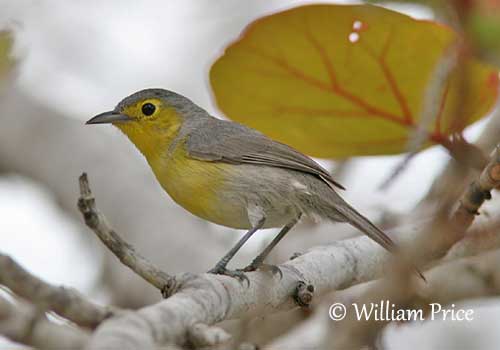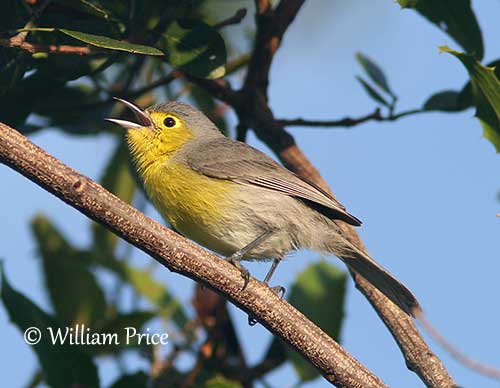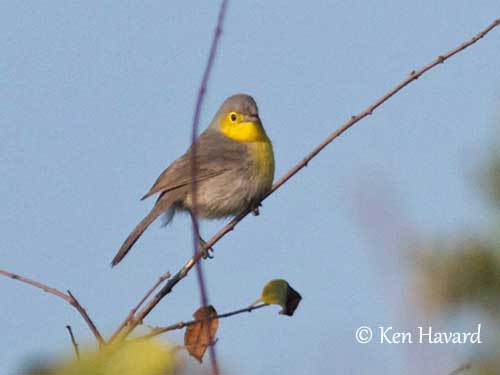Fr: Paruline d’Oriente
Ang: Oriente Warbler
All: Fornswaldsänger
Esp: Reinita de Oriente
Ita: Parula dell'Oriente
Nd: Forns Zanger
Sd: gulbröstad kubasångare
Photographers:
Ken Havard
My Bird Gallery & Flickr gallery 1 & Flickr gallery 2
William Price
PBase-tereksandpiper & Flickr William Price
Text by Nicole Bouglouan
Sources:
HANDBOOK OF THE BIRDS OF THE WORLD Vol 15 by Josep del Hoyo-Andrew Elliot-David Christie - Lynx Edicions – ISBN: 9788496553682
BIRDS OF THE WEST INDIES – by Herbert Raffaele, Kristin Williams et Tracy Pedersen – Helm – ISBN: 9780713649055
Neotropical Birds – Cornell Lab of Ornithology
Arthur Grosset's Birds (Arthur Grosset)
Cuba Explorer - Birds of Cuba - Endemic and near endemic birds of Cuba
A new subspecies of Oriente Warbler for Pico Turquino, Cuba, with ecological comments on the genus
By Orlando H. Garrido
Oriente Warbler
Teretistris fornsi (Family Uncertain)
Passeriformes Order – Parulidae Family
INTRODUCTION:
The Oriente Warbler is endemic to Cuba where it occurs in the eastern part of the island, whereas the Yellow-headed Warbler is found in the western part.
Both species are placed in the family Parulidae, but currently, this placement remains uncertain, following evidence from DNA sequence, with three missing molecules of DNA after various analysis. Research work on the New World warblers is still in progress, because these birds are evolving rapidly, with several very closely related genera, making often uncertain the placement of the species in one or another genus.
The Oriente Warbler frequents a variety of forests from lowlands to mountains, and the population appears currently stable.
DESCRIPTION OF THE BIRD:
Biometrics:
Length: 13 cm
Weight: 7,5/13 g
The Oriente Warbler adult has grey upperparts, including crown and nape. Face, throat, breast and upper belly are yellow, whereas lower belly and undertail-coverts are pale greyish-white. The flanks show a dull brownish tinge.
The fairly long, slightly down-curved bill is blackish, with grey cutting edges. The eyes are dark brown, surrounded by yellow eyering. Legs and feet are bluish-grey.
Male and female are similar, but the juvenile is not described.
RANGE:
The Oriente Warbler is found in Cuba and occurs in the eastern part of the island.

HABITAT:
The Oriente Warbler can be seen from lowland to high mountain forests with undisturbed understorey. It usually frequents the scrubby woodlands near the coast, whereas in mountainous areas, it prefers more humid forests. The species can be seen from sea-level up to 2000 metres of elevation.
CALLS AND SONGS: SOUNDS BY XENO-CANTO
The Oriente Warbler utters rapid, high-pitched chattering and a variety of buzzing and grating notes. The song is a series of buzzy notes, interspersed with sweeter notes “tsi-tsi-tsi…”
It also gives a sharp “tchip”. When alarmed, all the members of a group give loud, persistent rasping trill, usually repeated several times.

BEHAVIOUR IN THE WILD:
The Oriente Warbler feeds on insects, caterpillars, spiders and small lizards. Small fruits are occasionally consumed too.
It forages mainly in the understorey and on the ground. It is very active in the morning and forages higher, up to 5 metres or more above the ground. However, in the afternoon, it comes down to lower level and ground. It forages by “combing” (to go through something with a fine-tooth comb) the vegetation both horizontally and vertically.
It gleans insects and various invertebrates from the foliage, often by hovering. It probes into bark and wood crevices with the long bill, and in clumps of dead leaves. Coleoptera, Homoptera and Lepidoptera are the main prey.
The Oriente Warbler is gregarious outside breeding, and can be seen in mixed-species flocks or in smaller groups of 4-16 individuals. However, during the breeding season, both mates forage together.
The courtship behaviour of this species is unknown. As a sedentary species, it is probably monogamous and defends the territory all year round, including the richer feeding areas.
The displays are not described, but we can suggest that the bright yellow face, throat and breast are enhanced by adapted postures accompanied by songs.
The Oriente Warbler is sedentary in Cuba, and only performs short flights.
REPRODUCTION OF THIS SPECIES:
The breeding season takes place between March and July, with egg-laying in March-April.
The Oriente Warbler nests in forest and woodland. The nest is built on horizontal branch or among parasitic plants such as Tillandsia fasciculata. The nest is made with moss, fine grasses, rootlets and feathers, and is usually unlined. It is concealed within a tree fork covered with moss, about 90-110 centimetres above the ground.
The female lays 2-3 white eggs with greenish wash and darker markings on the larger end. The incubation lasts 8-9 days. The chicks are probably fed by both parents. They leave the nest 10-11 days after hatching.
PROTECTION / THREATS / STATUS:
The Oriente Warbler has very restricted range and it locally common in the eastern part of Cuba, and particularly common in the southern provinces of Granma, Santiago de Cuba and Guantánamo.
The population is stable, and the Oriente Warbler is currently evaluated as least Concern.
